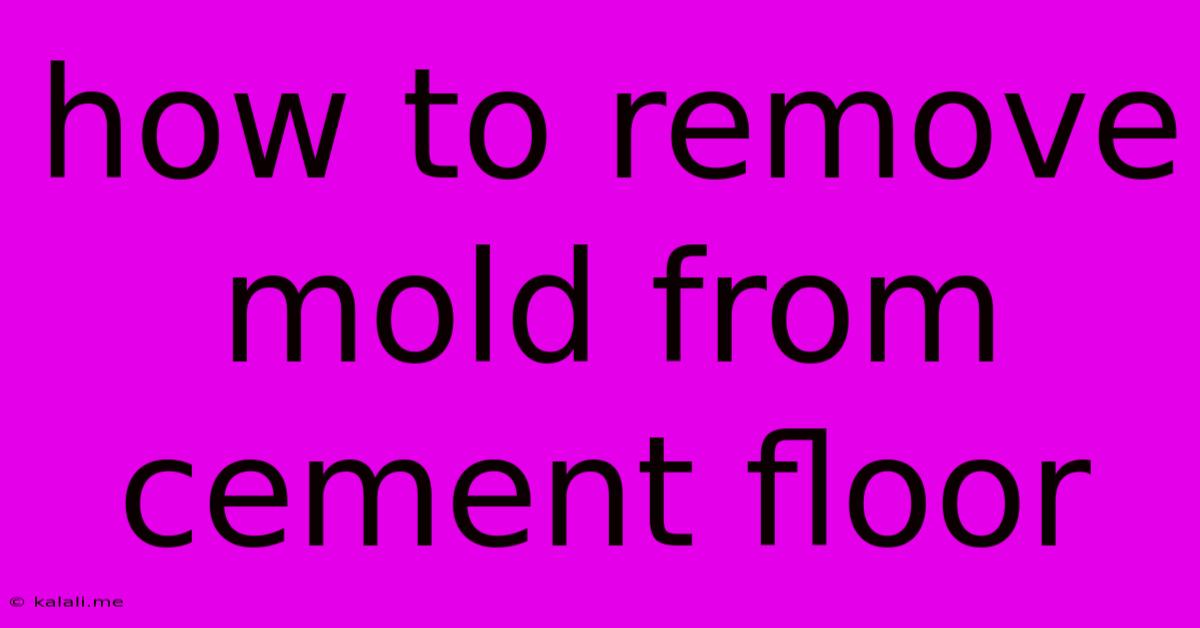How To Remove Mold From Cement Floor
Kalali
Jun 02, 2025 · 3 min read

Table of Contents
How to Remove Mold from a Cement Floor: A Comprehensive Guide
Mold on a cement floor is not only unsightly but can also pose health risks. Fortunately, with the right approach and safety precautions, you can effectively remove mold and prevent its return. This guide provides a step-by-step process for tackling this common problem, addressing everything from identifying mold to preventing future growth.
Understanding the Problem: Identifying and Assessing Mold
Before you start cleaning, it's crucial to identify the type and extent of the mold infestation. Small patches of mold can often be handled with DIY methods, while extensive growth might necessitate professional help. Look for discoloration, often black, green, gray, or white, accompanied by a musty odor. The texture can be fuzzy, slimy, or powdery. If you're unsure, or if the mold covers a large area (more than 10 square feet), it's best to consult a professional mold remediation specialist. They possess the expertise and equipment to safely handle extensive infestations.
Safety First: Protecting Yourself from Mold Spores
Mold spores can trigger allergic reactions or respiratory problems. Always prioritize safety:
- Wear protective gear: This includes a respirator (N95 mask or better), gloves (rubber or nitrile), and eye protection.
- Improve ventilation: Open windows and doors to increase airflow, helping to reduce spore concentration. Consider using fans to circulate air.
- Avoid disturbing the mold: Don't brush, vacuum, or scrub the mold before applying cleaning solutions, as this can spread spores.
Step-by-Step Mold Removal Process
Once you've assessed the situation and taken the necessary safety precautions, follow these steps:
1. Preparation:
- Clean the area: Remove any loose debris, dirt, or other materials from the affected area using a broom or shop vacuum. Remember to wear your protective gear.
- Isolate the area: If possible, contain the moldy area to prevent spore spread. This could involve taping plastic sheeting around the perimeter.
2. Cleaning Solution:
- Bleach solution (for small infestations): Mix one part bleach with ten parts water. This solution is effective against many types of mold. Caution: Bleach is corrosive; always wear protective gear.
- Commercial mold cleaner: Various commercial mold cleaners are available, often formulated for specific surfaces. Always follow the product's instructions carefully. These are sometimes preferable for porous surfaces.
- Vinegar solution (for mild cases): White vinegar is a natural, less harsh alternative. Dilute it with equal parts water. This is less effective against stubborn mold.
3. Application and Scrubbing:
- Apply the solution: Using a scrub brush, sponge, or spray bottle, apply the chosen cleaning solution liberally to the affected area. Allow the solution to dwell for at least 10-15 minutes to kill the mold.
- Scrub thoroughly: Scrub the area vigorously to remove the mold. For stubborn mold, you may need to repeat the process.
- Rinse thoroughly: After scrubbing, rinse the area with clean water. A pressure washer can be helpful for larger areas, but be mindful of causing damage.
4. Drying:
- Thorough drying is crucial: Ensure the floor is completely dry to prevent mold regrowth. Use fans, dehumidifiers, or open windows and doors to expedite drying.
Preventing Future Mold Growth
Mold thrives in damp environments. Prevent future growth by:
- Addressing moisture problems: Identify and repair any leaks, water damage, or sources of excessive humidity. This is paramount in preventing mold recurrence.
- Improving ventilation: Ensure adequate ventilation in the area to prevent moisture buildup.
- Regular cleaning: Regularly clean the floor to remove dirt and debris that can provide a breeding ground for mold.
- Sealing porous surfaces: If the cement is particularly porous, consider sealing it with a sealant designed to prevent moisture penetration.
When to Call a Professional
If you're dealing with a large infestation, persistent mold growth, or health concerns, contact a professional mold remediation service. They have the experience and equipment to safely and effectively remove mold.
This comprehensive guide provides a solid foundation for removing mold from your cement floor. Remember, safety is paramount, and prevention is key to avoiding future problems.
Latest Posts
Latest Posts
-
Csi Camera Ribbon Extenders 24 Pin
Jun 04, 2025
-
Blender Change Opacity Of Reference Image
Jun 04, 2025
-
Cost To Make Wall Inside Apartment With Sliding Glass Doors
Jun 04, 2025
-
Why Does Lego Use Different Colors For Technic Sets
Jun 04, 2025
-
Can You Put Latex Paint Over Oil
Jun 04, 2025
Related Post
Thank you for visiting our website which covers about How To Remove Mold From Cement Floor . We hope the information provided has been useful to you. Feel free to contact us if you have any questions or need further assistance. See you next time and don't miss to bookmark.